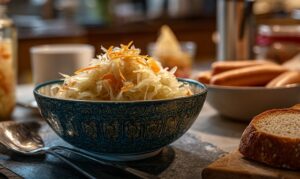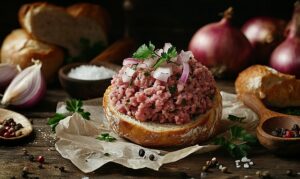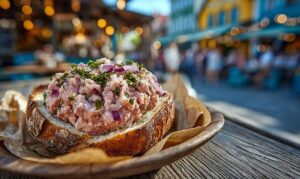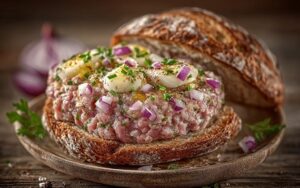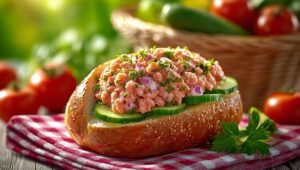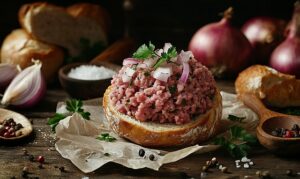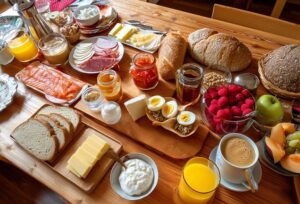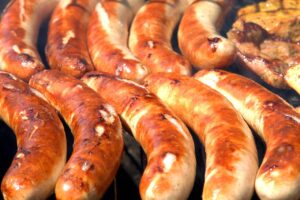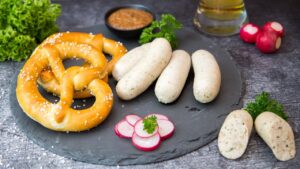Where History Meets a Hungry Crowd When most people think of German cuisine, they picture heavy plates served in cozy taverns. But there’s another side to Germany’s culinary culture - faster, louder, and served from a sizzling grill by the side of the road. German street food has a rich and surprising history. It’s not just about currywurst … [Read more...]
Why Sauerkraut Is Germany’s Superfood
More Than Just a Pickled Side Dish Crunchy, tangy, and oddly addictive, sauerkraut may look like a humble pile of fermented cabbage—but it’s one of the most powerful foods in the German culinary tradition. For centuries, sauerkraut has been a staple in German kitchens, served alongside sausages, potatoes, and roasts. But what many don’t realize … [Read more...]
10 Surprising Facts About Mettbrötchen
To many Germans, Mettbrötchen is just part of life – an everyday food item as familiar as coffee and bread. But this simple-looking raw pork sandwich hides a surprising amount of history, culture, controversy, and quirky charm. Whether you’re a curious newcomer or a lifelong fan, here are 10 fascinating facts about Mettbrötchen that go far … [Read more...]
Why This Raw Pork Sandwich Terrifies Americans
In Germany, it’s a humble breakfast snack. In America, it’s a food horror story. Few culinary items generate such visceral cross-cultural reactions as Mettbrötchen – the raw minced pork sandwich that sits proudly on German breakfast tables and buffet trays. For Germans, it’s familiar and comforting. For many Americans, it’s shocking, even taboo. … [Read more...]
Mett vs. Hackepeter: What’s the Difference?
Germany has a long tradition of enjoying raw pork dishes, but if you’ve spent any time exploring regional German foods, you might encounter two confusingly similar terms: Mett and Hackepeter. Both refer to minced raw pork and are often served on bread rolls with onions – but they aren’t quite the same thing. So what exactly is the difference … [Read more...]
What’s in a Mettbrötchen? Ingredients and Regional Tips
Mettbrötchen may be one of the simplest dishes in German cuisine – raw minced pork on a roll – but simplicity doesn’t mean uniformity. Across Germany, subtle differences in ingredients, preparation, and presentation create a surprisingly rich world of regional styles and family traditions. Whether you're a newcomer curious about what's actually … [Read more...]
Mettbrötchen: Germany’s Raw Pork Sandwich Explained
To the untrained eye - and especially the non-German stomach - Mettbrötchen might look like a culinary dare. Raw minced pork spread on a crusty bread roll, topped with raw onions, salt, and pepper? In many cultures, this would be a serious food safety concern. But in Germany, it’s a beloved breakfast item, a snack sold in bakeries and butcher … [Read more...]
Frühstück – Traditional German Breakfast
Forget quick bites and sugar-packed cereals. A traditional German breakfast—known as Frühstück—is a slow, hearty, and communal affair. Rich in bread, cheeses, and fresh ingredients, it sets the tone for a day rooted in nourishment, routine, and connection. In this article, we’ll explore what makes a German breakfast special, its cultural roots, … [Read more...]
German Knackwurst Recipe: A Delightful Culinary Journey
German cuisine is renowned for its hearty, flavorful dishes, and at the heart of this culinary tradition lies the Knackwurst. A type of German sausage known for its distinctive snap and rich flavor, Knackwurst is a staple in German festivals, beer gardens, and dinner tables. This article explores the history, preparation, and unique characteristics … [Read more...]
German Weißwurst Recipe – A Traditional Bavarian Delight
Germany is renowned for its rich culinary heritage, and one of its most cherished contributions is the Weißwurst. This traditional Bavarian white sausage, a staple in Munich and a highlight of Oktoberfest, has been savored since the 19th century. This article will guide you through the process of making Weißwurst at home, including tips on … [Read more...]

